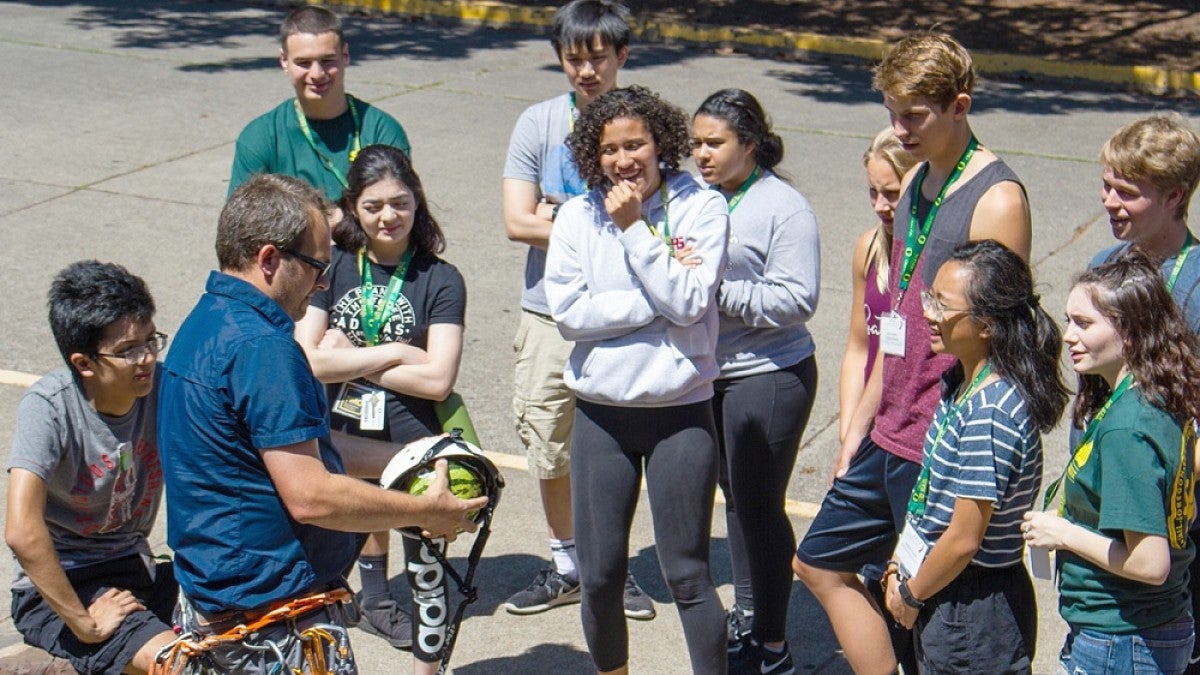Outside of the University of Oregon’s Student Recreation Center, professor Graham Kribs is throwing slabs of rock the size of footballs at helmet-covered watermelons to demonstrate basic principles of physics and proper climbing equipment.
This is one of the many ways the Summer Academy to Inspire Learning program, or SAIL, is advancing statewide academic outreach. SAIL was founded in 2005 by UO economics professors Bruce Blonigen and Bill Harbaugh, who wanted to introduce college life and interdisciplinary learning to middle- and high-school students from underrepresented backgrounds, including those from lower-income homes and those who would be the first in their families to attend college.
“We have students from Pendelton, Coos Bay, all across the state, and so many backgrounds,” said Lara Fernandez, SAIL’s program director. “The ability to quickly make personal connections is key to getting students to take the leap towards pursuing their education.”
For 14 years, SAIL has been offered free to students, with most funding for the program coming from private donations. Earlier this year, UO President Michael Schill approved a three-year, $225,000 commitment that allowed the program to expand its reach across the state by letting participating students stay on campus during the summer program.
Last summer, 500 students applied and 400 students participated. This summer SAIL received 1,500 applications and accepted 500 students to participate in week-long programs in one of 20 areas of study, including biology, product design, performing arts, environmental studies, physics and human physiology.
A revolving staff of 300 UO faculty members volunteer to teach at SAIL. Kribs uses watermelons, helmets, rock climbing — and rocks — to share physics in a new light. He sees the program as a part of a faculty member’s scholarly role to make science accessible and give back to the public.
“Rock climbing is a great activity because it involves so much basic, first-year physics and it’s something students are familiar with,” Kribs said.
In addition to faculty members, the program capitalizes on the talents of 40 undergraduate and graduate students who are hired, with support from donor funds, as counselors. Some of those students were former SAIL participants themselves.
Jorge Sandoval, a sophomore at Lane Community College, was a SAIL student for one year before becoming a counselor for the last two. He said that being able to watch students grow and connect with one another has been the best part of his experience.
“You get to meet a lot of new people from different schools, faculty from across campus, and discover what you want to do,” he said.
This is high school senior Lilly Plummer’s second year in SAIL. She said the residential aspect has been the highlight of her experience.
“It’s fun to be able to meet different people and talk about what we learned that day,” said Plummer, a student at Creswell High School.
Plummer said the physics and human physiology program solidified her ambition to become a pediatric doctor and learn how the body works in order to help others.
In addition to having the opportunity to explore different disciplines, students can create a community while they’re on campus.
“The community here is so close-knit, and everyone is putting effort into being here,” said Karen Vuong, a senior at Sheldon High School. Vuong, a fourth-year SAIL student, would like to pursue her undergraduate degree at the UO through a PathwayOregon or Diversity Excellence Scholarship.
During the academic school year, SAIL provides college preparatory mentoring services in local schools, using college students in a peer-to-peer model, as well as volunteer faculty.
“The highlight for me is to see so many students shine, see their confidence rise, recognize their ability and that they belong,” Fernandez said. “We see 75 percent of our students come for the full four years and 90 percent pursue a college degree after graduation. They realize that they can make a difference in their academic opportunities with this program. To see the repeated success, growth and involvement from our community, and now the state, keeps me going.”
—By Jess Brown, University Communications


